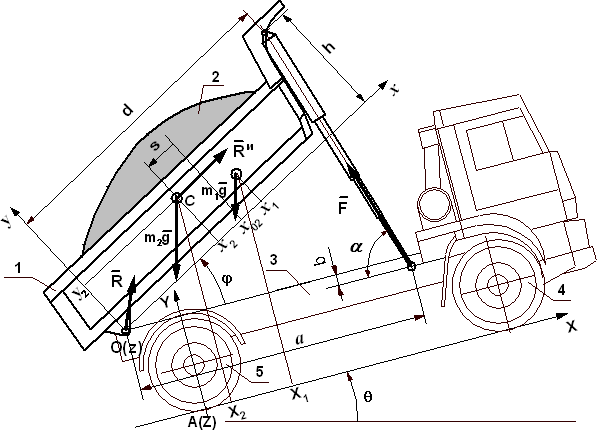Muratova D.M.
Master’s Degree student
Kazakh National Research Technical University after K.I. Satpayev
Akhmetova Sh.D.
Candidate of Technical Sciences
Kazakh National Research Technical University after K.I. Satpayev
DUMP TRUCK UNLOADING PROBLEM
SUMMARY
This article deals with the problem of the stability of a dump truck vehicle both during unloading and while driving. Analysis of recent studies has been conducted. That allowed us to establish operating modes at various values of the angle of inclination of the reference surface of motion. The question can finally be solved only by applying numerical methods and mathematical modeling, becoming a link in the next scientific research.
Keywords: vehicle, stability, dumping, truck, dynamics.
Introduction
Almost everyone has at least a vague idea what the terms stability and instability mean, but these ideas are often not precise enough for use in studying vehicle stability. Even engineers dealing with dynamics often use the terms in relatively imprecise ways that are nevertheless often useful. For example, in vehicle stability discussion, one often encounters the concepts of static and dynamic stability [1].
Stability and throughput are one of the most important factors in the performance properties of dump trucks, on which the safe use and further operation of the vehicle when performing transport and unloading operations depends.
The vehicle overturning can occur both in the longitudinal and in the transverse plane. For example, a loss of stability in the longitudinal plane can be observed when the car brakes abruptly on a steep descent. When this occurs, the separation from the road rear wheels. Tilting the car in the longitudinal plane is also possible when it is moving on a steep climb. In this case, the front wheels lose contact with the road surface. There are cases of vehicle tipping backwards when it is reversing into a ravine or river [2].
Under the transverse stability understand the ability of the vehicle to maintain contact of all wheels with the roadway. In most cases, the vehicle overturning in the transverse plane occurs:
• when driving at high speed in sharp bends;
• due to the abrupt termination of the side skid when a rear wheel hits a obstacle;
• in case of uneven arrangement of cargo in the back of a car or its movement on a turn, etc.
All of the above fully applies to dump trucks [3]. In addition, for this class of vehicle there is a risk of loss of stability of the vehicle during its unloading. Operating experience has shown that when unloading dump trucks on prepared flat sites, there is no separation of the wheels from the road bed [4]. The car overturns most often when unloading on inclined platforms. Moreover, the unloading site can have both longitudinal and transverse slope. In this regard, the main task in calculating the stability of the vehicle in such cases is to determine the maximum allowable angle of inclination of the unloading site, as well as the loads acting on the vehicle’s carrier system.
Depending on the direction of sliding or tipping, there is lateral or longitudinal stability. During the operation of the vehicle, the most likely and dangerous loss of lateral stability, which occurs as a result of the action of various lateral forces. Loss of lateral stability can occur as a result of curvilinear or rectilinear motion, or when performing unloading operations [5].
Analysis of research and publications
With the help of S.N. Pischov’s experimental research we have data on longitudinal and lateral stability indicators, which allow us to determine the tilting and sliding angles of prototypes, that is, dump trucks that participated in the experiment, namely MAZ-5516W4 and MAZ-4381, when performing transport and unloading operations. [6]
According to the results of experimental studies, the forces of resistance to movement and adhesion were determined taking into account the angle of inclination of automobiles dump trucks in the longitudinal plane and road conditions. That allowed us to establish operating modes at various values of the angle of inclination of the reference surface of motion.
Longitudinal stability of the dump truck
Consider the scheme of unloading a dump truck on a longitudinal slope (Fig. 1).

Fig.1. The design scheme of unloading a dump truck on the site with a longitudinal slope.
Denote:
m1 – platform mass 1; m2 – cargo weight 2; m3 – mass of other sprung units 3; m4 and m5 – mass front 4 and rear 5 axles of the vehicle; φ – platform lift angle; θ – discharge angle; s – moving cargo.
When lifting the platform when the total angle of the platform (j + q) becomes equal to the angle of repose, the load is set in motion. Let the cargo move as a monolithic block, symmetric about the plane of symmetry Oxy of the vehicle [7].
In the case when the inclination angle of the platform exceeds the critical angle, the front wheels are torn off from the unloading platform. In this case, the reaction of R1 goes to zero and equation finally takes the form:
) – ) + (cosφ — sinφ) = 0. (1)
However, to obtain an analytical expression for calculating the critical angle from equation (1) is not possible. That’s why we apply the procedure of step by step change of parameters. For this by and by ∆θ = 0.5º, increase the angle of the unloading platform. At each step, changing the angle φ, model platform lift. When the sum of the angles (φ + θ ) becomes equal to the angle of repose the movement of the cargo begins Substituting the obtained values into equation (1), we check the condition of the front wheels. If the sum of the moments included in equation (1) is less than or equal to zero, then the angle of the platform has reached a critical value and the truck will overturn. Otherwise, increment the angle θ and the procedure is repeated.
On the basis of the developed methodology, a program for calculating the longitudinal stability of dump trucks is compiled. The results can be useful at an early design stage for assessing the stability of dump trucks.
Transverse truck stability
Loss of stability of the truck can be observed during unloading on the cross slope. An analysis of modern methods for assessing the lateral stability of dump trucks has shown that the solution of this problem is developing in two directions [8].
Another approach to solving the problem is based on the use of computational research methods. However, this requires the creation of a complex mathematical vehicle model. Such a model should take into account the design features of the suspension guide, the nonlinearity of the elastic suspension elements and tires, as well as the possibility of plastic deformation of the supporting system during torsion. In this formulation, the problem can be solved only with the use of numerical methods and is the subject of serious scientific research.
So, on the complete finite element model of the KAMAZ-6520 vehicle, the critical angle of inclination of the unloading site was calculated [9]. The stiffness of the wheels, the stiffness of the springs and the position of the center of gravity of the cargo were recorded. Discrete, with a step of 0.5º, the angle of inclination of the vehicle was set and the platform lift was modeled. The critical angle of inclination of the site when unloading a dump truck was considered to be the angle at which the wheels broke off the ground, or plastic deformation of the supporting structure began. The calculations confirmed the known fact of criticality for dump trucks with increased carrying capacity of the platform inclination angle.
Note that the development and debugging of a similar vehicle model requires not only considerable time, but also the coordinated work of a team of high-class engineers. However, these costs can be justified, since the created model can also be used to calculate the dynamics and strength of the vehicle.
Conclusion
The article deals with the problem of stability of the dump truck during unloading on the site with longitudinal and transverse inclination. A procedure for step-by-step change of parameters for calculating the critical angle of inclination of the site is proposed. On the basis of the developed methodology, a program has been compiled for calculating the longitudinal stability and cargos acting on the carrier system of dump trucks. It is noted that to assess the stability when unloading a dump truck on a transverse slope requires the development of more complex non-linear models. This problem may be the subject of further scientific research.
The proposed approach allows already at an early design stage to carry out multivariate calculations of the dump truck for strength and stability in order to select the optimal design solution.
References
- Karnopp D. Vehicle Stability/ Karnopp D. — NY, U.S.A: Library of Congress, 2004. — 315 p.
- Kravets V.N. Teoriya avtomobilya. [Autocar theory]. — N. Novgorod: NGTU im. R.E. Alekseeva Publ., 2013. 413 p. (in Russian).
- Belokurov V.N., Gladkov O.V., Zaharov A.A., Melik- Sarkis’yants A.S. Avtomobili- samosvaly [Dump trucks]. — Moscow, Mashinostroenie Publ., 1987. 216 p. (in Russian).
- Mariev P.L., Kuleshov A.A., Egorov A.N., Zyryanov I.V. Karernyy avtotransport stran SNG v XXI veke [Career vehicles of CIS countries in the 21st century]. — St. Petersburg, Nauka Publ., 2006. 387 p. (in Russian).
- Pishchov S.N. [and others]. Rezul’taty ehksperimental’nyh issledovanij ustojchivosti avtomobilya MAZ povyshennoj prohodimosti [The result of experimental research of stability for off-road capability trucks MAZ] / Pishchov S.N. [and others.] — Trudy BGTU [Proceeding of BSTU]. — 2013.- № 2: Lesnaya i derevoobrabatyvayushchaya promyshlennost’ [Forest and Woodworking Industry]. 47-48 p. (in Russian)
- Pishchov S.N., Golyakevich S.A., Ariko S.E. Sravnitel’nyj analiz rezul’tatov ehksperimental’nyh issledovanij ustojchivosti i prohodimosti avtomobilej-samosvalov MAZ [Compare analysis of experimental results in stability and passability of dumptrucks MAZ] / Pishchov S.N., Golyakevich S.A., Ariko S.E. — Trudy BGTU [Proceeding of BSTU]. — 2016. — № 2. 45-48 p. (in Russian)
- Mastinu G., Ploechl M. Road and off-road vehicle system dynamics handbook. / Mastinu G., Ploechl M. — CRC Press, Taylor & Francis Group, 2014. XIV, 1662 p.
- Andreev A.F., Kabanau V., Vantsevich V. Driveline Systems of Ground Vehicles: Theory and Design. / Andreev A.F., Kabanau V., Vantsevich V. — CRC Press, Taylor & Francis Group, 2010. XXXIV, 758 p.
- The calculation of lateral stability while unloading the truck. Vibration strength Laboratory: website. Available at: http://lab106.ru/projects/kam3/kam3.html, accessed 01.05.2015. (in Russian).








